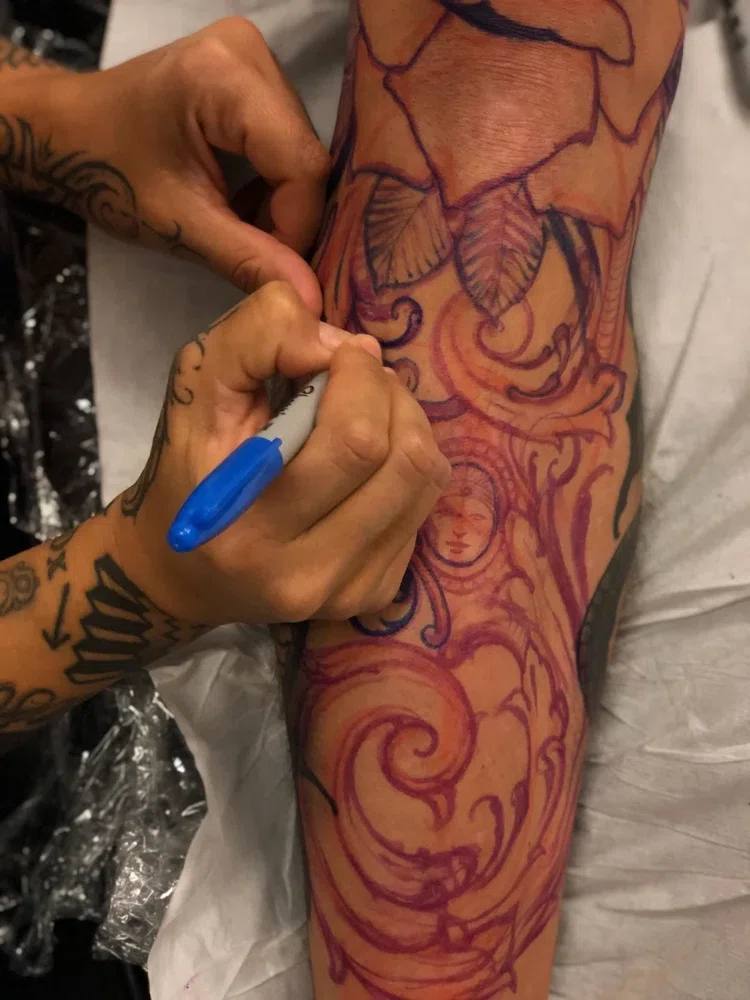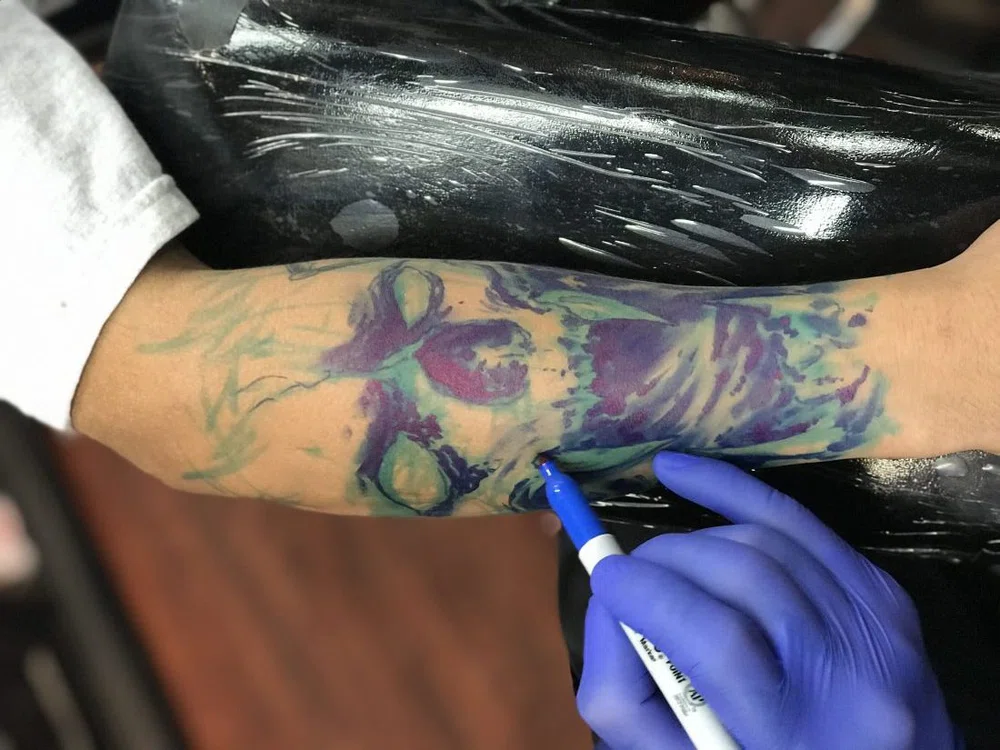Everything on FreeHand tattooing
Tips for mastering the Freehand technique in tattooing
04 January 2024
FreeHand tattooing is a technique that has become increasingly common in the tattoo world.
Freedom and flexibility are two of its main pillars.
It's a technique that adapts to almost any style and can be included in remarkable ways.
But beware, it's not all plain sailing, FreeHand requires a great deal of skill from the tattooist and an extensive understanding of tattooing supplies and techniques.
Want to know more? Stick around, we'll tell you all about it.
What is ‘FreeHand’ tattooing?
FreeHand tattooing is a technique by which the tattooist doesn't use a tattoo stencil or a previous design, but instead draws and tattoos directly on the client's skin.
It's considered one of the most complex techniques to master because it requires tons of practice and control of all the tools to achieve a unique piece without mistakes.
Unlike traditional tattooing with a stencil, in FreeHand tattooing, precision becomes a greater challenge because not having a stencil to guide each stroke can lead to mistakes.
However, freehand tattooing allows you to create a fully customised design that precisely fits the curvature of the body in areas where a stencil cannot adapt so easily.
It can also be considered by many as a one-of-a-kind work of art in itself, as the tattoo can be created on the spot, never to be repeated.
Freehand tattooing offers many possibilities, and this is why it's becoming widely used in the professional world.
How to freehand tattoo and what to consider?

The key to FreeHand tattooing is to have overall good tattooing skills. In other words, it's a technique that requires certain experience and that's why it's not recommended for beginners.
On the other hand, some people believe that drawing knowledge is crucial for this type of work because it gives you agility and ability when it comes to drawing lines and outlining figures.
We will never tire of saying that learning to draw for tattooing is essential for any artist, regardless of what style they work in. And in this specific case, we could say that it's an excellent tool for solving problems and the unexpected.
But one thing doesn't negate the other. If you have great drawing skills, but you lack practice and have poor technique, you'll always be halfway through. And vice versa.
That's why, if you want to tattoo FreeHand, we recommend that you practice a lot first.
You can try freehand tattooing on synthetic skin to find out how you feel tattooing without a guide. You'll find it's an entirely different experience.
Some frequently asked questions about FreeHand
It's natural to have many doubts when approaching this type of tattooing. The first and most frequent is:
1- Can any style be tattooed FreeHand?
Technically, yes. But be careful, don't be overconfident. As you know, some tattoo styles are much more complex than others. Realism, for instance.
To tattoo Realism, you need a lot of technical knowledge, drawing and composition. And even if you are an expert, you must have some guidelines and supporting points to be able to tattoo with precision.
This is why it's risky to affirm that any style can be tattooed in FreeHand.
2- What are the tricks to FreeHand tattooing?
Broadly speaking, FreeHand can be done in two ways: either by drawing the tattoo with a marker, or by tattooing directly on the client's skin without any guide.
The first one involves drawing the main lines of the design with an indelible marker, thus drawing something similar to a handmade stencil on the skin.

This method is commonly used by tattoo artists because it allows them to have greater control over potential mistakes, as well as to design the tattoo together with the client and make any necessary modifications.
Some recommend using at least two colours in the markers: a very light one and another darker. With the lighter colour, you mark the basic tattoo structure, that is, something like a first sketch.
And then, with the darker colour, you define the lines that finally remain in the tattoo. Always remember to use skin-friendly markers. Usually, Sharpie markers are the best choice.
Finally, the second way of tattooing FreeHand is to tattoo the client's skin without a previous design or reference point.
This is the riskiest and hardest of all because it requires great confidence and mastery of all the tools, techniques and needles, as well as the client's complete trust in you. That's why we don't recommend it to everyone.
Tip: some tattooists, aside from marking with indelible, use a brush and, with hectographic ink, literally paint the shaded areas and some other details that stand out in the design. This is totally up to each person's taste, and you should practice a lot before doing it.
3- Can you tattoo Freehand with any kind of needle?
Objectively speaking, yes, because the design can be as diverse as you want it to be. But you need to thoroughly know about the types and sizes of needles to decide which one(s) to use.
If you want to know more about this, we invite you to read our article Guide to tattoo needles.
4- Is it the same to tattoo in colour as with black ink?
The experience of tattooing in color or only with black inks is totally different.
Tattooing in colour can be more complicated in a certain sense because it requires more knowledge in terms of colour theory, and more control on tones, saturation, and colour mixing.
Also, if your intention, for example, is to do a FreeHand tattoo that involves gradients, you must be almost an expert at this because, without a stencil, you can really mess it up.
On the other hand, it's convenient to work only with black inks, as you may have less to worry about. Meaning, the job will be easier because you'll be limited to using just one colour instead of many.
Many tattoo artists suggest starting with black designs to master the FreeHand technique, and then gradually increasing the difficulty. As, for example, adding dilutions, different types of shading and, finally, more daring colours and styles.
In short, tattooing with colour is never the same as tattooing only with black. But you can do it as you wish, as long as you have all the necessary knowledge to tackle one technique or the other.
To find out more about colour, click here, and we'll tell you everything you need to know about the chromatic circle and its importance in colour tattooing.
A good tattoo is defined by its final result
Although FreeHand tattooing is a rather complex technique to master, it is still a powerful tool to stand out as an artist. And if you are interested in challenges, this method can be a great source of learning and improvement.
Still, bear in mind that to reduce risks as much as possible, you will have to practice as much as possible before tattooing a client.
And never forget that what remains of a tattoo is always the final result, regardless of the technique used during the tattooing process. So, try to do it because you know it will look good, and not to show off.
Also keep in mind that, when tattooing freehand, your client puts all his trust in your skills. Something very valuable that you must take care of at all costs and take it with the seriousness it deserves. Trust is lost more easily than it's gained. And if they don't trust you, chances are that they won't choose you again, nor recommend you.
That being said, if you feel you have what it takes and have trained enough to take the plunge, go ahead! You'll have a great advantage to stand out from other tattoo professionals.
We hope this article has encouraged you to practice and bring out the best in you as an artist!
Know what's the best way to boost your tattooing skills? A detailed step-by-step guide that includes everything that's involved in this complex but exciting profession. From the theory, through the methodology and putting into practice everything you learn about technique. Aspects that we cover in depth in our intensive professional tattoo courses.